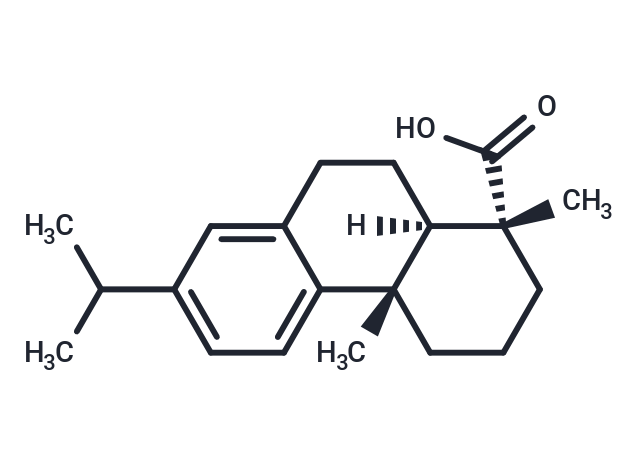Shopping Cart
- Remove All
 Your shopping cart is currently empty
Your shopping cart is currently empty

1. Dehydroabietic acid (Dehydroabietate) (DAA) is an EBV-EA activation inhibitor. 2. DAA is a useful food-derived compound for treating obesity-related diseases, by decreasing plasma glucose, insulin levels, plasma triglyceride (TG) , and hepatic TG levels. 3. DAA derivatives displays anti-secretory and anti-pepsin effect in animal models.

| Pack Size | Price | Availability | Quantity |
|---|---|---|---|
| 2 mg | $35 | In Stock | |
| 5 mg | $55 | In Stock | |
| 10 mg | $97 | In Stock | |
| 25 mg | $183 | In Stock | |
| 50 mg | $276 | In Stock | |
| 100 mg | $397 | In Stock | |
| 500 mg | $937 | In Stock | |
| 1 mL x 10 mM (in DMSO) | $62 | In Stock |
| Description | 1. Dehydroabietic acid (Dehydroabietate) (DAA) is an EBV-EA activation inhibitor. 2. DAA is a useful food-derived compound for treating obesity-related diseases, by decreasing plasma glucose, insulin levels, plasma triglyceride (TG) , and hepatic TG levels. 3. DAA derivatives displays anti-secretory and anti-pepsin effect in animal models. |
| Alias | Dehydroabietate |
| Molecular Weight | 300.44 |
| Formula | C20H28O2 |
| Cas No. | 1740-19-8 |
| Smiles | C[C@@]12[C@]([C@@](C(O)=O)(C)CCC1)(CCC=3C2=CC=C(C(C)C)C3)[H] |
| Relative Density. | 1.058g/cm3 |
| Storage | Powder: -20°C for 3 years | In solvent: -80°C for 1 year | Shipping with blue ice. | |||||||||||||||||||||||||||||||||||
| Solubility Information | Chloroform, Dichloromethane, Ethyl Acetate, Acetone, etc.: Soluble DMSO: 50 mg/mL (166.42 mM), Sonication is recommended. | |||||||||||||||||||||||||||||||||||
Solution Preparation Table | ||||||||||||||||||||||||||||||||||||
DMSO
| ||||||||||||||||||||||||||||||||||||

Copyright © 2015-2025 TargetMol Chemicals Inc. All Rights Reserved.